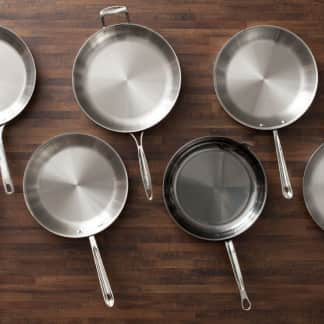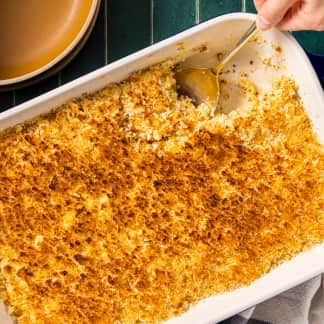The Knapp Made Classic CM Scrubber, a 4 by 4-inch square of interlinked stainless-steel rings (the “CM” stands for “chain mail”), makes easy work of cleaning stuck-on food out of cast-iron pans. Recently, Knapp Made released a new model, the Small Ring CM Scrubber, that is larger overall (it’s about 5 by 5 inches) and has smaller, thinner rings. To see which scrubber was better, we put the two models to the test, cleaning up a range of messes not only on plain cast iron but also on dark enameled cast iron, stainless steel, and heat-resistant glass—all types of cookware that the manufacturer claims the scrubbers can handle.

The good news is that both scrubbers did a stellar job of removing gunk from all of the pans. The bad news is that they both scratched and damaged the enameled and stainless-steel pans—we don’t recommend that you use either scrubber on those types of pans. But if you stick with plain cast iron and Pyrex, these scrubbers work very well for big messes.


A new stainless-steel skillet before and after scrubbing; note the scratched surface on the right.
Which is better? We prefer the newer scrubber to the original by a hair. Because of its larger size, the Small Ring CM Scrubber was easier to handle and covered more territory more quickly than the original, taking between 10 seconds and 2 minutes less to clean the same kinds of messes. And its smaller, narrower rings made it more agile and better at maneuvering around corners and detailing hard-to-access areas (like the grooves of our grill pan). These scrubbers are metal, so go easy—if you use excessive force, you can strip the seasoning from cast-iron pans and even scratch their surface.

The Tests
- Cook bacon in a regular cast-iron skillet and clean
- Scramble eggs in an enameled cast-iron skillet and clean
- Cook hamburgers on an enameled cast-iron grill pan and clean
- Burn teriyaki sauce in a stainless-steel skillet and clean
- Cook lasagna in a glass baking dish and clean
- Time all cleaning tests
- Clean the scrubbers themselves between tests and time how long it takes
How We Rated
- Performance: We cooked a pound of bacon in a 12-inch cast-iron skillet, scrambled eggs in an enameled cast-iron skillet, cooked hamburgers on an enameled cast-iron grill pan, burned teriyaki sauce in a stainless-steel skillet, and slow-cooked lasagna in a 13 by 9-inch glass baking dish. Then we timed how long it took to clean each piece of cookware with each scrubber. We gave more points to the scrubber that took less time to clean up all the different messes.
- Maneuverability: We evaluated how easily the scrubbers scoured the sides, corners, and grooves of the different pans in each of the cleaning tests. We awarded more points to the more agile scrubber.
- Cleanup: Between cleaning sessions, we cleaned the scrubbers themselves by hand, using 140-degree water and a teaspoon of our favorite dish soap, and timed how long it took to remove any trapped or melted food particles from the scrubbers. We gave more points to the scrubber that was easier to clean by hand.
- Removes all types of residue well
- Larger size for more efficient cleaning
- Smaller rings for greater agility








